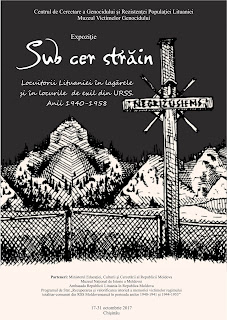On Tuesday, September 17th, 2017, at 15:00 hours, at the National Museum of History of Moldova was opened the exhibition „UNDER THE ALIEN SKIES: Lithuanian people in Soviet hard labor camps and exile in 1940-1958". The exhibition is organized by the Museum of Genocide Victims from the Genocide and Resistance Research Centre of Lithuania.
The event was organized by the National Museum of History of Moldova in cooperation with the Embassy of the Republic of Lithuania to the Republic of Moldova through the State Program "Recovery and Historical Valorization of the Memory of Victims of the Totalitarian-Communist Regime in the Moldavian SSR in 1940-1953".
At the opening ceremony, moderated by the general director of the National Museum of History of Moldova, Eugen Sava, took the floor: Gheorghe Postică, Deputy Minister of Education, Culture and Research of the Republic of Moldova; Andrei Didenko, Adviser at the Lithuanian Embassy in Chisinau; Eugenijus Peikštenis, director of the Museum of Genocide Victims; Prof. univ. dr. hab. Anatol Petrencu, director of the State Program "Recovery and historical valorization of the memory of the victims of the totalitarian-communist regime in MSSR during the years 1940-1941 and 1944-1953"; Dr. Ludmila Cojocaru, project director of the State Program.
The aim of the exhibition is to tell the citizens of Europe, especially the young generation, about the crimes committed by the Soviet totalitarian regime on the territory of Lithuania. The exhibition was made with documents and materials from the Museums of Genocide Victims, the Special Archive and the Central State Archives of Lithuania from Vilnius, the Lithuanian National Museum, the Museum of Deportations, Exile and Resistance in Kaunas, the Alka Museum from Žemaitia Region and the Regional Museum of Tauragė.
The exhibits tell us about the organization of deportations, arrests with political substrates, the unbearable life of deportees and prisoners in the camps, working and living conditions. The 20 stands, arranged according to the thematic principle, reflect the most diverse aspects of the daily life of deportees and political prisoners: food, clothing, faith, etc. They reveal the differences in living conditions of exiled people compared to political prisoners in the camps. The emotion transmitted by images, letters, and documents related to the conditions of the political prisoners is increased by the motifs of barbed wire, which is obsessively repeated on the stands.
The exhibition was presented for the first time on June 21, 2011, at a meeting in the Parliament of Europe, with the title "Present and Past, Face to Face". That event was dedicated to the 70th anniversary of the beginning of deportations in Lithuania. Subsequently, the exhibition was presented in Poland, France and the United Kingdom, also in several cities and institutions in Lithuania.




















































